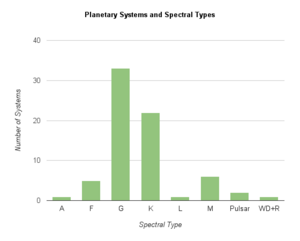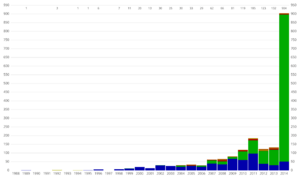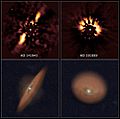Planetary system facts for kids
A planetary system is a group of planets and other space objects that orbit around a star. Our own Solar System is a planetary system! Scientists have found many other stars with their own planetary systems.
In the 21st century, we've learned a lot about planetary systems. By 2014, scientists had found 1,795 planets in 1,116 different systems. Some of these systems have many planets, like our Solar System. There are even more systems that scientists are still checking!
The closest planetary system we know for sure is called Gliese 832. It's about 14.8 light years away and has one planet. Another nearby system, Alpha Centauri, is only 4.37 light-years away. Scientists think it might have a planet similar in size to Earth, but they are still confirming it. The closest system with multiple planets is Gliese 876, which has four planets and is about 15.3 light-years away.
Scientists are very interested in the "habitable zone" of planetary systems. This is the area around a star where conditions might be just right for extraterrestrial life to develop.
What are Multiplanetary Systems?

Multiplanetary systems are stars that have at least two confirmed planets orbiting them, besides our own Solar System.
As of June 2014, out of 1,116 stars known to have exoplanets, 461 of them were multiplanetary systems. About 280 of these had only two confirmed exoplanets. However, some have many more! Our Sun holds the record with 8 confirmed planets. Other stars like Kepler-90 and HD 10180 each have 7 confirmed exoplanets. Scientists even think HD 10180 might have 9 planets in total!
Gliese 876 is the closest multiplanetary system to us, with 4 confirmed exoplanets. It's about 15 light years away. There are 12 known multiplanetary systems closer than 50 light-years from Earth. Most of these systems are much farther away. The farthest confirmed multiplanetary system is OGLE-2012-BLG-0026L, which is an amazing 13,300 light-years away!
The way a planetary system forms depends a lot on the mass and metallicity of its star. Stars with higher mass and more metallicity (meaning they have more elements heavier than hydrogen and helium) tend to have more planets, and those planets are often more massive.
Images for kids
-
Heliocentric model of the Solar System in Copernicus' manuscript
-
An artist's concept of a protoplanetary disk
-
Protoplanetary discs observed with the Very Large Telescope.
-
Debris disks detected in HST archival images of young stars, HD 141943 and HD 191089, using improved imaging processes (April 24, 2014).
-
90% of planets with known distances are within about 2000 light years of Earth, as of July 2014.
See also
 In Spanish: Sistema planetario para niños
In Spanish: Sistema planetario para niños








